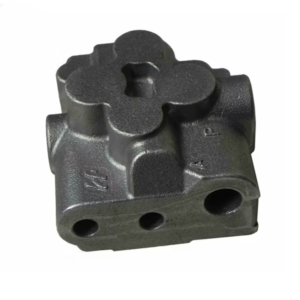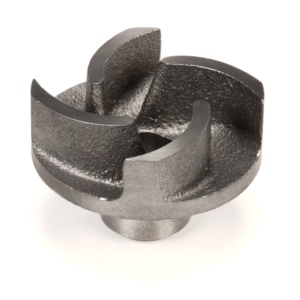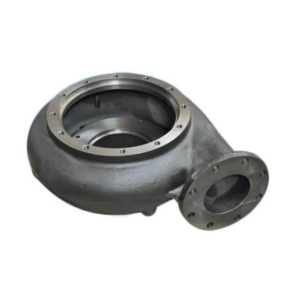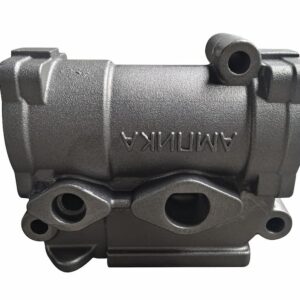Agricultural machinery castings are important components of agricultural machinery. They are high strength, hardness, wear resistance, and toughness to meet the complex and harsh working of farmland.
Casting Material
Gray iron castings: Low cost, with excellent cast ability, wear resistance, and shock absorption, but poor toughness. They are widely used in low-stress structural parts such as housings, bases, and brackets.Casting Parts: Transmission housings, clutch housings, plowshares, plowshares, wheels, pulleys, etc.
Ductile iron castings: Their strength, toughness, and wear resistance better than gray cast iron, approaching steel. They are an ideal material for critical parts in agricultural machinery because of complex stresses and impact loads. Main Parts: Tractor chassis parts, drive hubs, gears, crankshafts, connecting rods, differential housings, etc.
Wear-resistant iron castings: Rotary tiller shafts, pulverizer hammers, plow tips, harrow blades, etc.
Steel castings: Higher strength, toughness, and plasticity, and can withstand significant impact loads. Casting properties and shock absorption are inferior to cast iron
Alloy steel castings: Special mechanical properties, such as high strength, high wear resistance, or low-temperature impact resistance
Parts: Large gears, sprockets, blade holders, track shoes on harvesters, suspension brackets for heavy tractors, booms for excavators, etc.
Non-ferrous metal castings
Aluminum alloy castings: Offer light weight, excellent thermal conductivity, and corrosion resistance. Primarily used for components requiring weight reduction or heat dissipation.
Parts: Engine cylinder heads, carburetors, water pump housings, harvester cab components, etc.
Copper alloy castings: Offer excellent wear resistance, corrosion resistance, and thermal conductivity, and are primarily used for wear-resistant and transmission components.
Parts: Bearings, bushings, valves, etc.

Hydraulic cating parts
Ductile cast iron EN-GJS-400-700

water pump impeller
Gray cast iron EN-GJL-200-250

Water pump housing
Gray iron casting parts EN-GJL-250/300

Pully castings
Gray cast iron HT200-HT300 Material

Water pump body
Grey cast iron parts HT250/GJL-250

Cover casting
Ductile cast iron EN-GJS-500-700
Agricultural machinery castings Manufacturing process
Mainly are sand casting, investment casting, and die casting. Sand casting is the main casting process and is suitable for producing various shapes and sizes castings. Investment castings are used in high-precision and high-surface quality castings, such as engine cylinder heads. Die casting is suitable for the production of thin-walled and complex-shaped castings, such as gears and bearings.In the manufacturing process, factors such as the selection of raw materials, smelting process, pouring temperature, and mold design will affect the quality and performance of castings.
Common defects and solutions of Agricultural machinery castings
Common defects such as pores, slag inclusions, and cracks may occur in agricultural machinery castings during the production process. These defects will not only reduce the performance and reliability of the castings, but also affect the overall performance and operating efficiency of agricultural machinery.
For these defects, take the following solutions :
Optimize the smelting process: Increase the smelting temperature, strengthen the stirring and exhaust during the smelting process, and reduce the generation of pores and slag inclusions.
Improve mold design: Rationally design the mold structure to avoid mold overheating and deformation, and reduce the generation of cracks.
Ductile iron is carbon in the form of spherical graphite. Its mechanical properties are far superior to those of gray iron and close to those of steel. It has excellent casting, cutting and wear resistance, and has a certain degree of elasticity. It is widely used in the manufacture of high-end castings such as crankshafts, gears, pistons, and various mechanical parts.
Details
Details:
Model
Material
Brand
Origin
Application
Agriculture castings
Ductile Iron QT450-10
Shengrong
China
crankshafts, gears, pistons, and various mechanical parts
Agricultural machinery casting process
The raw materials required for agricultural machinery investment casting include alloy materials, gypsum powder, silicone rubber, ultraviolet photosensitive materials, cycloidal steel, glass fiber, etc. Among them, alloy materials are one of the most important raw materials, and different castings require different alloy materials.
Mold making
Mold making is the most tedious part of the investment casting process, and its purpose is to make a mold suitable for precision casting. The specific production steps are as follows:
1) Design mold structure: According to the shape and size of the casting, design a suitable mold structure and determine the corresponding mold size.
2) Make sample mold: Use ultraviolet photosensitive materials to make sample molds and add corresponding casting channels.
3) Make casting molds: Use silicone rubber to make casting molds and fill them with gypsum powder, cycloidal steel, glass fiber and other materials.
4) Process the overall mold: Combine the sample mold and the casting mold according to the design requirements to form an overall mold.
Casting process
The valve body of investment casting is the core link of investment casting, which directly affects the quality of castings. The specific process flow is as follows:
1) Preheating the mold: Before casting, the entire mold needs to be preheated to a certain temperature to ensure the quality of the casting.
2) Melting alloy materials: Put the pre-measured casting alloy materials into a high-temperature furnace for melting.
3) Injection into the mold: Inject the molten alloy material into the preheated mold and let it stand in the mold for a period of time to ensure that the casting is fully solidified.
4) Cooling the casting: After the casting is completely solidified, put the mold into cooling water and wait for the casting to cool.
Subsequent processing
After the above casting process, the entire process of precision casting is completed. There are some subsequent processing links, including mold separation, casting grinding, surface treatment, heat treatment, etc.
1) Mold separation: remove the cast casting from the melt and separate the mold.
2) Casting grinding: fine-tune the surface of the casting to ensure that the accuracy and size of the casting meet the design requirements.
3) Surface treatment: apply an antioxidant to ensure that the surface of the casting will not corrode due to oxidation.
4) Heat treatment: heat and cool the casting at a certain temperature to eliminate internal stress and improve the strength and wear resistance of the casting.
Quality Control Methods in Casting Material Production
The quality control methods in casting material production mainly include raw material inspection, production process control, finished product inspection and quality management system construction. The following are specific quality control methods:
1.Raw material inspection: At the beginning of casting material production, the raw materials should be comprehensively inspected to ensure that the quality of the raw materials meets the requirements. The inspection content includes the chemical composition, physical properties, appearance and size of the raw materials. According to the specific requirements of different casting materials, chemical analysis, microstructure analysis, mechanical properties testing and other methods can be used for inspection.
2. Production process control: During the casting process, it is necessary to strictly control the process parameters of each link to ensure that the production process is stable and controllable. Production process control includes the control of smelting, pouring, cooling and other links, and real-time monitoring and adjustment of the production process to ensure stable product quality.
3. Finished product inspection: Comprehensive inspection of the finished products, including appearance quality, dimensional accuracy, performance testing and other aspects. Finished product inspection can be carried out through visual inspection, dimensional measurement, chemical analysis, destructive and non-destructive testing and other methods to ensure that the products meet relevant standards and customer requirements.
4. Quality management system construction: Establishing a sound quality management system is the key to ensuring the quality of casting material production. The quality management system includes the formulation of quality control standards, the standardization of quality management processes, the training of quality management personnel, etc. By establishing a quality management system, comprehensive quality management can be achieved and product quality levels can be improved.

